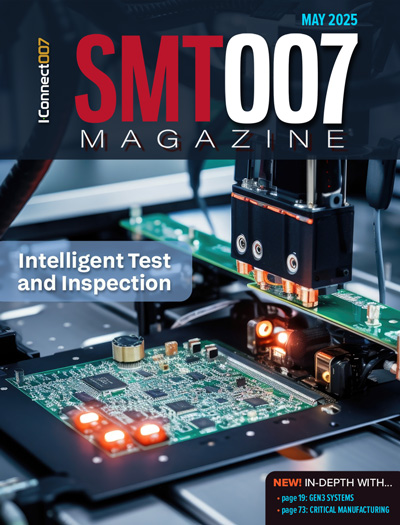-

- News
- Books
Featured Books
- smt007 Magazine
Latest Issues
Current Issue
What's Your Sweet Spot?
Are you in a niche that’s growing or shrinking? Is it time to reassess and refocus? We spotlight companies thriving by redefining or reinforcing their niche. What are their insights?

Moving Forward With Confidence
In this issue, we focus on sales and quoting, workforce training, new IPC leadership in the U.S. and Canada, the effects of tariffs, CFX standards, and much more—all designed to provide perspective as you move through the cloud bank of today's shifting economic market.

Intelligent Test and Inspection
Are you ready to explore the cutting-edge advancements shaping the electronics manufacturing industry? The May 2025 issue of SMT007 Magazine is packed with insights, innovations, and expert perspectives that you won’t want to miss.
- Articles
- Columns
- Links
- Media kit
||| MENU - smt007 Magazine
CyberOptics’ John Hoffman to Present during Technical Session at SMTAI 2015
September 4, 2015 | CyberOptics CorporationEstimated reading time: 2 minutes
CyberOptics Corporation today announced that Senior Image Processing Research Engineer John Hoffman, PhD will present during the technical session ‘Advances in Process Controls, From 3D Printing to 3D Inspection to Measuring Thermal Expansion Mismatch’, scheduled to take place Wednesday, September 30, 2015 from 2-3:30 p.m. at SMTA International in Rosemont, IL.
The presentation, “Addressing High Precision Automated Optical Inspection Challenges with Unique 3D Technology Solution”, will be presented by Dr. Hoffman based on a manuscript penned by CyberOptics’ Todd Liberty and Tim Skunes.
Driven by the continued decrease in the size of electronics packaging, combined with the increase in density, there is a critical need for highly accurate 3D inspection for defect detection.
Using multi-view 3D sensors and parallel projection, it is possible to capture more of the board at a faster rate as compared to serial image acquisition which is more time-consuming. Precise 3D image representation can then be generated using sophisticated fusing algorithms that take the multiple captured images and fuse them into one precise 3D image. The result is high speed 3D inspection.
Multi-reflection suppression (MRS) technology enables highly accurate 3D measurement by meticulously identifying and rejecting reflections caused by shiny components and reflective solder joints. MRS algorithms use a very rich data set from multiple cameras at every location. Combined with sophisticated algorithms that fuse the image data from multiple cameras, multiple reflections are effectively suppressed. By contrast, 3D sensing solutions that use triangulation illumination without MRS run into measurement accuracy issues since solder joints create multiple reflections that can corrupt height image. This technology is a key building block for achieving high accuracy at production speed with an Automated Optical Inspection (AOI) system.
About CyberOptics
CyberOptics Corporation (NASDAQ: CYBE) is a leading global developer and manufacturer of high precision sensing technology solutions. CyberOptics sensors are being used in general purpose metrology and 3D scanning, surface mount technology (SMT) and semiconductor markets to significantly improve yields and productivity. By leveraging its leading edge technologies, the company has strategically established itself as a global leader in high precision 3D sensors, allowing CyberOptics to further increase its penetration of its key vertical segments. Headquartered in Minneapolis, Minnesota, CyberOptics conducts worldwide operations through its facilities in North America, Asia and Europe.
Statements regarding the Company’s anticipated performance are forward-looking and therefore involve risks and uncertainties, including but not limited to: market conditions in the global SMT and semiconductor capital equipment industries; increasing price competition and price pressure on our product sales, particularly our SMT systems; the level of orders from our OEM customers; the availability of parts required to meet customer orders; unanticipated product development challenges; the effect of world events on our sales, the majority of which are from foreign customers; rapid changes in technology in the electronics markets; product introductions and pricing by our competitors; the success of our 3D technology initiatives; expectations regarding LDI and its impact on our operations; integration risks associated with LDI and other factors set forth in the Company’s filings with the Securities and Exchange Commission.
Suggested Items
Driving Innovation: Direct Imaging vs. Conventional Exposure
07/01/2025 | Simon Khesin -- Column: Driving InnovationMy first camera used Kodak film. I even experimented with developing photos in the bathroom, though I usually dropped the film off at a Kodak center and received the prints two weeks later, only to discover that some images were out of focus or poorly framed. Today, every smartphone contains a high-quality camera capable of producing stunning images instantly.
Hands-On Demos Now Available for Apollo Seiko’s EF and AF Selective Soldering Lines
06/30/2025 | Apollo SeikoApollo Seiko, a leading innovator in soldering technology, is excited to spotlight its expanded lineup of EF and AF Series Selective Soldering Systems, now available for live demonstrations in its newly dedicated demo room.
Indium Corporation Expert to Present on Automotive and Industrial Solder Bonding Solutions at Global Electronics Association Workshop
06/26/2025 | IndiumIndium Corporation Principal Engineer, Advanced Materials, Andy Mackie, Ph.D., MSc, will deliver a technical presentation on innovative solder bonding solutions for automotive and industrial applications at the Global Electronics A
Fresh PCB Concepts: Assembly Challenges with Micro Components and Standard Solder Mask Practices
06/26/2025 | Team NCAB -- Column: Fresh PCB ConceptsMicro components have redefined what is possible in PCB design. With package sizes like 01005 and 0201 becoming more common in high-density layouts, designers are now expected to pack more performance into smaller spaces than ever before. While these advancements support miniaturization and functionality, they introduce new assembly challenges, particularly with traditional solder mask and legend application processes.
Knocking Down the Bone Pile: Tin Whisker Mitigation in Aerospace Applications, Part 3
06/25/2025 | Nash Bell -- Column: Knocking Down the Bone PileTin whiskers are slender, hair-like metallic growths that can develop on the surface of tin-plated electronic components. Typically measuring a few micrometers in diameter and growing several millimeters in length, they form through an electrochemical process influenced by environmental factors such as temperature variations, mechanical or compressive stress, and the aging of solder alloys.


